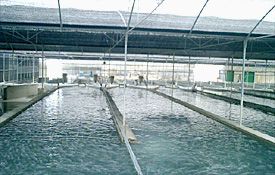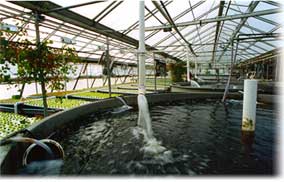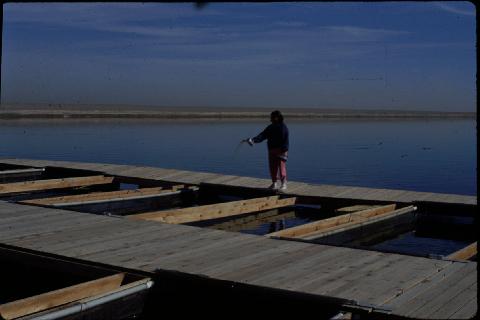Aquaculture
"Give a man a fish and you feed him for a day, teach the man how to grow that fish and you
feed him for life."
-Ancient Chinese Proverb 500 B.C.
What is aquaculture? Aquaculture is one of the fastest growing sectors of food
production in the world and there is much hope that it will be the supplement
to dwindling wild fisheries (9). Fish is the most
important source of protein for many diets, particularly those in rural, coastal
communities. A UN Food and Agriculture (FAO) report estimates that fish provides
close to 50% of people's animal protein intake per year (8).
Continually depleting stocks in wild fish populations have led to an increased
interest in the aquaculture of commercial fish to supply this protein, as well
as reducing the pressure put on wild populations. Aquaculture itself is the
cultivation of the natural production of fish, shellfish and aquatic plants
through close husbandry efforts (8). Mariculture
specifically refers to marine aquaculture; it is a specialized subset of aquaculture.
Typically, aquaculture is used to cultivate fish and shell fish for seafood
markets and human consumption, however, it also supplies exotic fish for the
hobby industry and game fish for the growing sportfish industries. The aquaculture
of seahorses looks promising. Industrialized nations have succeeded in rearing
them, but not yet to the level which alleviates the harvesting pressures caused
by the medicinal and hobby trades. The hope is that eventually seahorse aquaculture
will become simple enough that it could be practiced by poor fishermen, thus
providing an alternative to catching wild seahorses.
Aquaculture has been around for thousands of years. Ancient Chinese manuscripts
from the 5th century B.C. indicate that the Chinese practiced the fish culture
of Carp in rice patties (4). The ancient Hawaiians
furthered these methods by building pens to breed
and raise Carp
and
Talapia (7). Since then, aquaculture
has been vastly improved and separated into two major categories:
intensive and extensive aquaculture.
Figure 1.
 Intensive
aquaculture relies on technology to raise fish in artificial tanks
at very high densities. Aquaculturalists must have a thorough understanding
of the targeted
species so that water quality, temperature levels, oxygen levels, stocking
densities,
and feed are set at the optimal level to promote growth, reduce stress,
control disease, and reduce mortality (Figure 1) (4).
Due to the complete control of these factors,
intensive aquaculture produces high
yields
and
since it
can
be
done throughout
the year,
it can
be planned to correspond with foreseeable shortages in desired fish. Intensive
aquaculture has a very high start up
cost and requires much labor and currently, only rich countries
have developed this into a profitable
business. Research is being done to find viable species which can thrive in
an aquaculture setting.
Intensive
aquaculture relies on technology to raise fish in artificial tanks
at very high densities. Aquaculturalists must have a thorough understanding
of the targeted
species so that water quality, temperature levels, oxygen levels, stocking
densities,
and feed are set at the optimal level to promote growth, reduce stress,
control disease, and reduce mortality (Figure 1) (4).
Due to the complete control of these factors,
intensive aquaculture produces high
yields
and
since it
can
be
done throughout
the year,
it can
be planned to correspond with foreseeable shortages in desired fish. Intensive
aquaculture has a very high start up
cost and requires much labor and currently, only rich countries
have developed this into a profitable
business. Research is being done to find viable species which can thrive in
an aquaculture setting.
Although intensive aquaculture is completely mechanized and self-contained
it can have a detrimental impact on the environment. The biggest problem caused
by intensive aquaculture is the difficulty in properly dealing with the nutrient
rich effluent (4). Effluent contains high levels
of both organic and inorganic nutrients like ammonia, phosphorus, dissolved
organic carbon, dissolved organic nitrogen and dissolved organic phosphorus
(19). If not disposed of correctly the effluent
could cause a number of problems including eutrophication,
and hypernutrification (10). Ingenious solutions
have been developed to reduce the negative effects to the environmental caused
by this effluent. The most effective solution is the advent of aquaponics. Aquaponics
is the combination of intensive aquaculture (fish farming) and hydroponics (growing
plants without soil) (Figure 2). Aquaponic systems use the nutrient rich effluent
from fish tanks as fertilizers for produce. The advent of aquaponics has made
the aquaculture industry into a sustainable and eco-friendly business (4).
Figure 2.
 Extensive aquaculture is the other form of fish farming.
Extensive aquaculture is more basic than
intensive
aquaculture
in that less effort is put into the husbandry
of the fish. Extensive aquaculture is done in the ocean, natural
and man-made lakes,
bays,
rivers,
and Fiords. Fish are contained within these habitats by multiple mesh enclosures
which also function as trapping nets
during harvest (Figure 3) (4).
Since
fish
are susceptible to the elements, site placement is essential to
ensuring
rapid
growth
of the targeted species. The drawback of these facilities is that they depend
on
the
surrounding
area
for good
water
quality in order to reduce mortality and increase the survivorship
and
growth
rate
of the
fish (19).
Fish chosen for extensive aquaculture are very hardy and often do well in high
densities.
Seaweed, prawns, muscles, carp, talapia, tuna and salmon are the most
prominent
forms
of extensive aquacultured seafood (8).
Extensive aquaculture is the other form of fish farming.
Extensive aquaculture is more basic than
intensive
aquaculture
in that less effort is put into the husbandry
of the fish. Extensive aquaculture is done in the ocean, natural
and man-made lakes,
bays,
rivers,
and Fiords. Fish are contained within these habitats by multiple mesh enclosures
which also function as trapping nets
during harvest (Figure 3) (4).
Since
fish
are susceptible to the elements, site placement is essential to
ensuring
rapid
growth
of the targeted species. The drawback of these facilities is that they depend
on
the
surrounding
area
for good
water
quality in order to reduce mortality and increase the survivorship
and
growth
rate
of the
fish (19).
Fish chosen for extensive aquaculture are very hardy and often do well in high
densities.
Seaweed, prawns, muscles, carp, talapia, tuna and salmon are the most
prominent
forms
of extensive aquacultured seafood (8).
Picture of Aquaponics facility provided by acuaponiaGranja.jpg
Extensive aquaculture facilities have negative impacts on the environment as
well. Natural habitats are destroyed in the development of man made ponds used
for extensive aquaculture. In the Philippines, shrimp aquaculture is responsible
for the destruction of thousands of acres of mangrove fields which serve as
nurseries and living habitats for many marine organisms. Benthic habitats are
being depleted due to the high amount of organic waste produced by the fish
which settles below their pens(4). Phytoplankton
and algae breakdown fecal matter and residual fish meal reducing the amount
of available oxygen in the  water
column,which chokes and kills the Benthic organisms. Another serious problem
acquainted with extensive aquaculture is the introduction of invasive species
into ecosystems (10). Escaped fish increase the
competition between organisms for limited resources. Also, when foreign fish
interbreed with wild species, they upset the genetic variability of the species,
making them more prone to disease and infection. The high density of fish in
these mesh tanks is very tempting for predators of the sea and air (19).
To protect the harvest from predators protective netting is set up at a high
cost. Often times predatorial fish and mammals like seals, sharks, and tuna
get caught in these barrier nets and die. Some farmers protect their stocks
from predatorial birds such as pelicans and albatross by shooting these sometimes
endangered creatures.
water
column,which chokes and kills the Benthic organisms. Another serious problem
acquainted with extensive aquaculture is the introduction of invasive species
into ecosystems (10). Escaped fish increase the
competition between organisms for limited resources. Also, when foreign fish
interbreed with wild species, they upset the genetic variability of the species,
making them more prone to disease and infection. The high density of fish in
these mesh tanks is very tempting for predators of the sea and air (19).
To protect the harvest from predators protective netting is set up at a high
cost. Often times predatorial fish and mammals like seals, sharks, and tuna
get caught in these barrier nets and die. Some farmers protect their stocks
from predatorial birds such as pelicans and albatross by shooting these sometimes
endangered creatures.
Figure 3. Example of fish cages used in extensive
aquaculture of catfish (35)
Today, only industrialized nations have the funds to invest
in intensive aquaculture.
Much like
how industrialized farms in the U.S. have out-competed the small time farmer
off of their land, industrialized aquaculture is driving the small time fishermen
out of the sea. Mass produced aquacultured fish has lowered the wholesale
price of fish, thus drawing customers away from the already poor fishermen.
Today, the
only form of aquaculture available to small time fishermen is in the form
of grow out pens for
juvenile
fish. Research
is being done to create more complex and affordable forms of extensive
aquaculture for subsistence fishermen in order to increase their
standard of
living, and more importantly, act as an incentive to protect endangered
species (see sustainable
fishing methods).
View my extensive aquaculture experiment here
Look at pictures of my Pygmy Seahorses here
Look at a sustainable aquaculture facility here.
On to Conservation Policy
 Intensive
aquaculture relies on technology to raise fish in artificial tanks
at very high densities. Aquaculturalists must have a thorough understanding
of the targeted
species so that water quality, temperature levels, oxygen levels, stocking
densities,
and feed are set at the optimal level to promote growth, reduce stress,
control disease, and reduce mortality (Figure 1) (4).
Due to the complete control of these factors,
intensive aquaculture produces high
yields
and
since it
can
be
done throughout
the year,
it can
be planned to correspond with foreseeable shortages in desired fish. Intensive
aquaculture has a very high start up
cost and requires much labor and currently, only rich countries
have developed this into a profitable
business. Research is being done to find viable species which can thrive in
an aquaculture setting.
Intensive
aquaculture relies on technology to raise fish in artificial tanks
at very high densities. Aquaculturalists must have a thorough understanding
of the targeted
species so that water quality, temperature levels, oxygen levels, stocking
densities,
and feed are set at the optimal level to promote growth, reduce stress,
control disease, and reduce mortality (Figure 1) (4).
Due to the complete control of these factors,
intensive aquaculture produces high
yields
and
since it
can
be
done throughout
the year,
it can
be planned to correspond with foreseeable shortages in desired fish. Intensive
aquaculture has a very high start up
cost and requires much labor and currently, only rich countries
have developed this into a profitable
business. Research is being done to find viable species which can thrive in
an aquaculture setting.  Extensive aquaculture is the other form of fish farming.
Extensive aquaculture is more basic than
intensive
aquaculture
in that less effort is put into the husbandry
of the fish. Extensive aquaculture is done in the ocean, natural
and man-made lakes,
bays,
rivers,
and Fiords. Fish are contained within these habitats by multiple mesh enclosures
which also function as trapping nets
during harvest (Figure 3) (
Extensive aquaculture is the other form of fish farming.
Extensive aquaculture is more basic than
intensive
aquaculture
in that less effort is put into the husbandry
of the fish. Extensive aquaculture is done in the ocean, natural
and man-made lakes,
bays,
rivers,
and Fiords. Fish are contained within these habitats by multiple mesh enclosures
which also function as trapping nets
during harvest (Figure 3) ( water
column,which chokes and kills the Benthic organisms. Another serious problem
acquainted with extensive aquaculture is the introduction of invasive species
into ecosystems (
water
column,which chokes and kills the Benthic organisms. Another serious problem
acquainted with extensive aquaculture is the introduction of invasive species
into ecosystems (